How to Polish Marble Countertops — 4 Simple Steps for a Sparkling Space and the Common Mistakes You Should Avoid
Make your countertops look as radiant as ever without the fear of causing damage by following this expert-informed guide
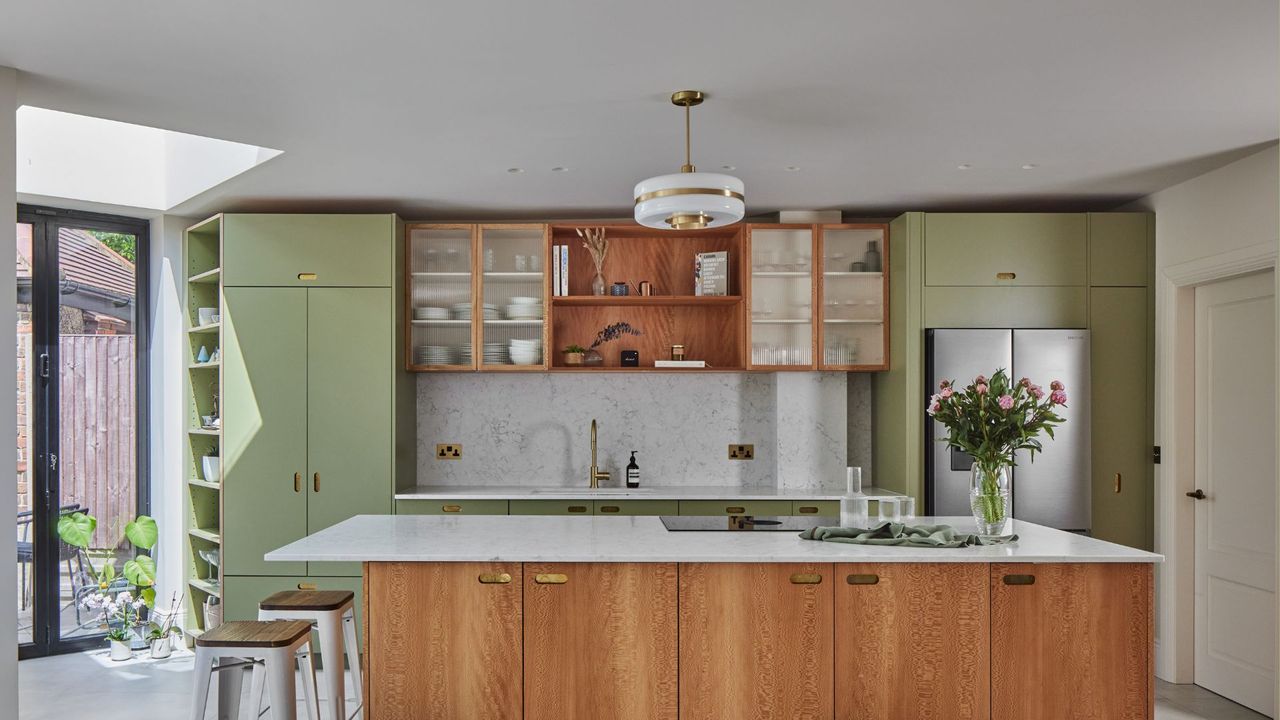

Countertops are one of the main pillars of a kitchen's functionality and aesthetic: dominant visually and in constant use.
Learning how to clean countertops is vital to maintaining their appearance and durability, but if you'd like your marvelous marble installations to revert to their once-brand-new gleaming state, there are ways to revive their former beauty.
Here, I talked to professional cleaners to learn how to polish and remove stains from marble to get them sparkling with no fear of causing damage. Marble is a delicate material, but that doesn't mean it won't welcome a good spruce. Here's how to do it.
What You'll Need
- Non-abrasive cleaning cloths or microfiber cloths. The MR.SIGA microfiber cleaning cloths from Walmart are a popular choice
- pH-neutral marble cleaner. The Weiman granite cleaner & polish from Walmart is also suitable for quartz, slate, limestone and marble surfaces
- Marble polishing power or compound — TENAX's marble polishing powder from Amazon comes recommended by one of the cleaning experts I talked to
- Buffing pads or a soft cloth — your microfiber cloths will do the trick
- Marble sealant. The 511 seal & enhance by Miracle Sealants Store, available on Amazon, is a good choice. Using a marble sealant is optional but will add an extra layer of protection to your countertops
- A soft sponge or applicator. The great value non-scratch sponges from Walmart have over 8,000 positive reviews
How to Polish Marble Countertops
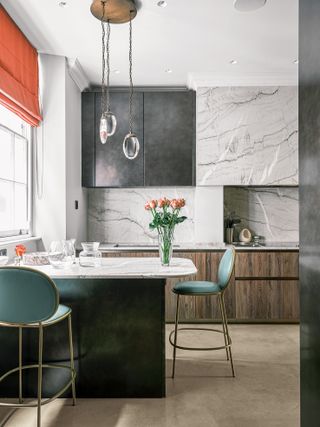
A good place to start while tackling your household cleaning schedule would be to clean your countertops. And after you've given it a good clean you can begin the process of polishing them to perfection.
It's important to do these two things first to prevent crumbs and debris from getting in the way of your polishing and potentially becoming sealed into your marble if you apply a sealant coating.
Muffetta Krueger, owner of Muffetta's Housekeeping, shares the following four-step guide to polish your countertops once they're looking spick and span.
1. Apply a Polishing Powder

The primary step in polishing your marble countertops is to apply a marble polishing powder — a powder that is different than what is needed to polish and clean granite countertops or other kinds of materials. This powder will work to help remove any lingering discoloration, oil stains, or light rust marks post-cleaning and give the entire surface an unmatched glow.
"To use a marble polishing powder, all you need to do is sprinkle a small amount of the powder onto your countertops when they are damp," says Muffetta.
Adding a little water to your countertop surfaces will help the powder to form a paste that can be buffed into the marble to encourage that much-desired shine. Don't forget to remove your countertop appliances and other items first to make the polishing job easier and more thorough.
2. Buff the Surface
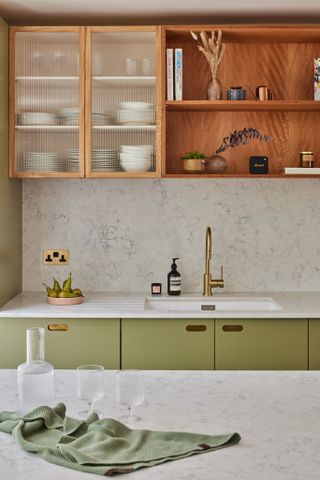
Next, it's time to buff the polishing powder on your marble countertops into the marble. You can do this using a low setting on a buffing machine or with some good old-fashioned elbow grease. However, it's important to note that you don't need to buff your surfaces very hard, as marble is a rather soft kind of stone.
"Use a buffing pad or soft cloth in circular motions to polish the marble," says Muffetta. "For deeper shine, consider a low-speed buffing machine. Avoid applying excessive pressure regardless of which method you use though to help prevent damage from occurring."
You will know your polishing powder has been buffed into your marble countertops enough when you see the surface becoming visibly more shiny.
3. Rinse and Dry
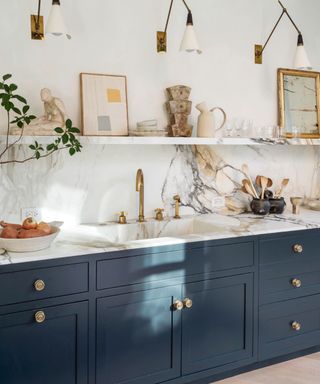
Once your marble countertops have reached the shine you've been seeking, you can give them a wipe-down to remove remnants of marble polishing powder from the surface. If you don't do this, dull patches and watermarks can accumulate on your countertops, as well as a gritty texture.
"Wipe away the polishing compound with clean water and a microfiber cloth," says Muffetta. "Then, to ensure the surface is completely dry and avoids water spots, dry your countertops completely using a separate microfiber cloth."
These cloths can be cleaned either in the dryer or by hand after use.
4. Seal the Marble (optional)
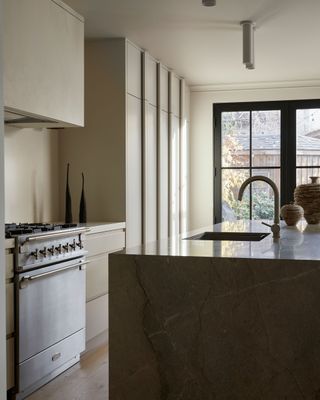
Lastly, you can optionally apply a layer of marble sealant over your countertops to lock in their sensational shine and protect the surfaces from stains for longer. Though this is an optional step, it's definitely something we believe is worth the extra work to protect your kitchen countertop materials.
"For added protection, apply a marble sealant," says Muffetta. "This step helps prevent future stains and etching, especially in high-traffic areas."
You can apply marble sealant over your countertops by adding a small amount to another microfiber cloth and buffing it onto the surface gradually.
FAQs
Mistakes to Avoid When Polishing Marble Countertops
Karina Toner, operations manager and professional cleaner at Spekless, detailed the five most common mistakes a person makes when polishing their marble countertops, as well as how to avoid them and have low-maintenance kitchen countertops in the future. It's highly important to get clued up on these potential blips as they can be detrimental to the longevity of your marble's shine.
1. Using Acidic Cleaners: Acidic substances like vinegar, lemon juice, or harsh chemical cleaners can etch and dull marble.
How to Avoid: Stick to pH-neutral cleaners designed for natural stone.
2. Skipping the Sealing Step: Marble is porous and prone to staining from spills. Without a protective seal, liquids can penetrate and cause permanent damage.
How to Avoid: Seal marble countertops every 6-12 months, depending on usage
3. Using Abrasive Tools or Scrubbing Too Hard: Scrubbing with steel wool or harsh sponges can scratch the marble’s surface.
How to Avoid: Use soft microfiber cloths or non-abrasive sponges for cleaning and polishing.
4. Leaving Spills Unattended: Prolonged exposure to acidic or pigmented liquids can stain marble.
How to Avoid: Wipe up spills immediately using a damp cloth.
5. Applying Too Much Polish: Overuse can result in a cloudy residue that’s hard to remove.
How to Avoid: Follow the product instructions carefully and use sparingly.
Be The First To Know
The Livingetc newsletter is your shortcut to the now and the next in home design. Subscribe today to receive a stunning free 200-page book of the best homes from around the world.

Ciéra is a writer and regional laureate with particular passions for art, design, philosophy and poetry. As well as contributing to Livingetc, she's an Editorial Assistant for Design Anthology UK and a contributing writer for Homes & Gardens and Apartment Therapy. Previous commendations of hers include being Highly Commended by The Royal Society of Literature and receiving a prestigious MA Magazine Journalism scholarship to City, University of London.
-
 This Strangely-Shaped Side-Sleeper Pillow Is Going Viral for Super-Charging Beauty Sleep — And Preventing Wrinkles
This Strangely-Shaped Side-Sleeper Pillow Is Going Viral for Super-Charging Beauty Sleep — And Preventing WrinklesThis silk-wrapped, ergonomically designed pillow is winning over wellness gurus — and its unusual shape might be the secret to waking up flawless
By Julia Demer Published
-
 McGee & Co’s Outdoor 2025 Collection Is Designed to Survive Whatever Life Throws at It — Yes, Even Red Wine
McGee & Co’s Outdoor 2025 Collection Is Designed to Survive Whatever Life Throws at It — Yes, Even Red WineSun, rain, working from home, and the occasional spilled glass? No problem. This outdoor collection makes an oasis out of everyday obstacles
By Julia Demer Published
-
 Houseplant Trends — What to Choose, and How to Style and Care for It in 2025
Houseplant Trends — What to Choose, and How to Style and Care for It in 2025According to plant experts, these are the seven houseplant trends to keep an eye out for this year
By Amiya Baratan Published
-
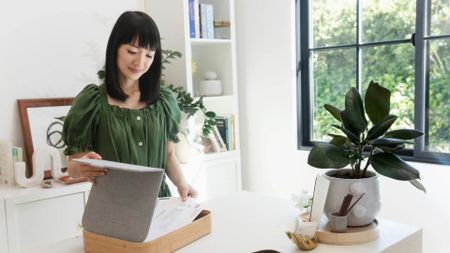 Marie Kondo's 5 Tricks for an Organized Entryway Helped Me Cut My Clutter — And Uncover the Value of Space
Marie Kondo's 5 Tricks for an Organized Entryway Helped Me Cut My Clutter — And Uncover the Value of SpaceKnown for her expertise in the field of decluttering and home organization, Marie Kondo's word is all we need to get our entryways sorted once and for all.
By Amiya Baratan Published
-
 The 'Decluttering Scavenger Hunt' Turns This Household Chore Into a Game (That You Could Totally Play With the Kids Today)
The 'Decluttering Scavenger Hunt' Turns This Household Chore Into a Game (That You Could Totally Play With the Kids Today)The 'gamification 'of decluttering might just make clearing your clutter more tolerable — this is a solution for all the task-averse
By Amiya Baratan Published
-
 This 'Strict' 50% Rule Will Help You Cut Your Home's Clutter in Half (Even If You're a Sentimentalist)
This 'Strict' 50% Rule Will Help You Cut Your Home's Clutter in Half (Even If You're a Sentimentalist)Is this rule strict? Maybe. Successful? Absolutely.
By Amiya Baratan Published
-
 How to Care for a ZZ Plant — Do This If You Want Lush, Green Foliage in Your Home
How to Care for a ZZ Plant — Do This If You Want Lush, Green Foliage in Your HomeFrom temperature to soil requirements, this expert guide holds all the information to care for this stylish houseplant successfully
By Amiya Baratan Published
-
 I'm Taking on This Decluttering Challenge for Lent — 40 Items to Say Goodbye to in 40 Days
I'm Taking on This Decluttering Challenge for Lent — 40 Items to Say Goodbye to in 40 DaysDuring lent, we recommend taking part in this decluttering challenge to pare back your home and have it Easter-ready. So here are 40 things to start with.
By Amiya Baratan Published
-
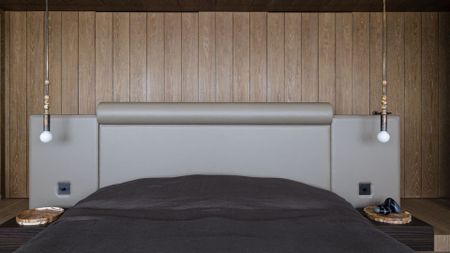 3 Things That Really Matter When Choosing Your Headboard If You Want a Bedroom With Good 'Energy'
3 Things That Really Matter When Choosing Your Headboard If You Want a Bedroom With Good 'Energy'When it comes to picking the perfect headboard, here are three key concepts to keep in mind for good Feng Shui
By Amiya Baratan Published
-
 9 Things You Can Do to Organize Your Dining Room That Will Make the Whole Space Work So Much Better
9 Things You Can Do to Organize Your Dining Room That Will Make the Whole Space Work So Much BetterThese nine expert-approved organization tips will take your dining room from messy to guest-ready in no time
By Amiya Baratan Published